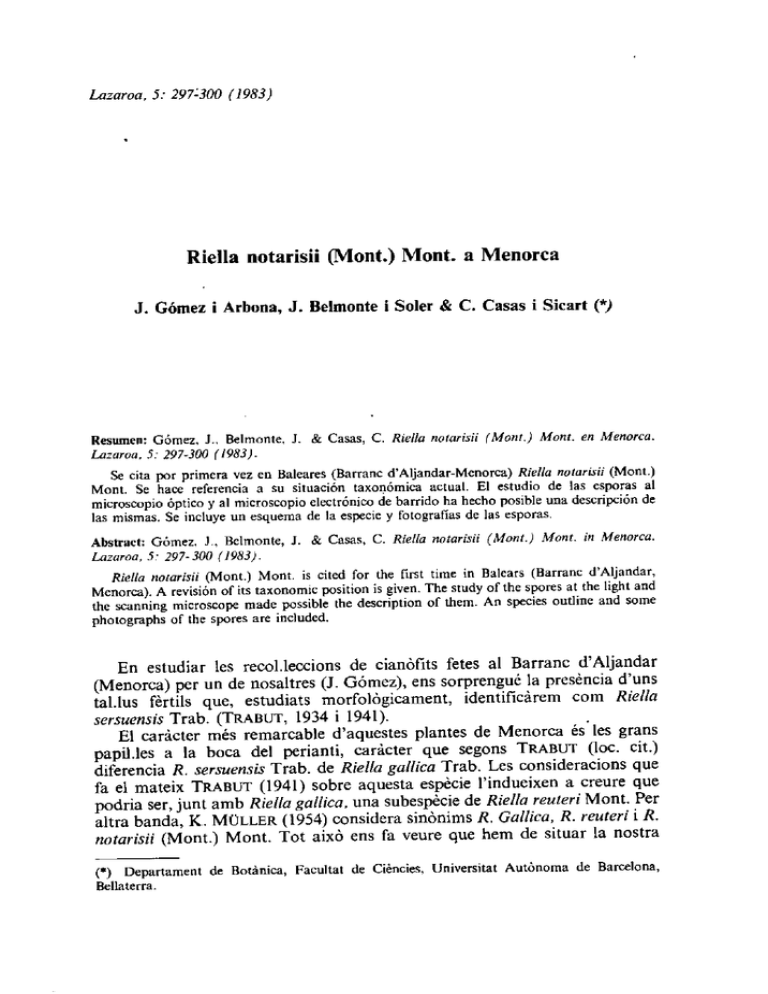
image from: https://www.researchgate.net/publication/287528370_On_the_presence_of_Riella_notarisii_Riellaceae_in_the_peninsular_Italy
Exploring the Fascinating World of Riella Moss
Introduction
Have you ever heard of Riella notarisii (Mont.) Mont., a unique species of moss in the Riellaceae family? Also known simply as Riella, this intriguing plant is worth learning more about. In this blog post, we’ll dive into the details of Riella moss, from its distinctive morphology to its global distribution and ecological roles. Get ready to discover the wonders of this tiny but mighty moss!
Background on Riella Moss
Riella moss belongs to the division Marchantiophyta and class Marchantiopsida. The Riellaceae family contains only the genus Riella, with around 19 known species worldwide. Riella mosses are considered thallose liverworts, meaning they have a flattened, leaf-like structure called a thallus rather than true leaves like other mosses.
Morphology and Identification
One of the most striking features of Riella notarisii is its unique thallus morphology. The thallus is typically

image from: https://studylib.es/doc/5657818/riella-notar¡si¡–mont.–mont.-a-menorca
1-3 cm long and forms a rosette or fan-like shape. It has a distinct midrib and wavy, lobed margins. The thallus is usually bright green in color and somewhat translucent.
Riella mosses are

image from: https://www.researchgate.net/figure/Figure-Photo-des-observations-realisees-suite-a-la-mise-en-germination-des-echantillons_fig32_340096207
dioicous, meaning male and female reproductive structures are on separate plants. The male plants produce antheridia (sperm-producing structures), while female plants have

image from: https://www.researchgate.net/publication/287528370_On_the_presence_of_Riella_notarisii_Riellaceae_in_the_peninsular_Italy
archegonia (egg-producing structures). After fertilization, the female plants develop sporophytes that contain spores for reproduction.
Global Distribution and Habitat
Riella notarisii has a widespread but scattered distribution across several continents, including Europe, Africa, Asia, and Australia. However, it is considered rare in many regions and is often overlooked due to its small size and specific habitat requirements.

image from: https://www.researchgate.net/publication/40836839_Riella_helicophylla_Bory_Mont_Mont_Sphaerocarpales_Manchantiophyta_en_el_territorio_valenciano
This moss species typically grows in temporary or ephemeral water bodies, such as seasonal pools, lake margins, and intermittent streams. It prefers

image from: https://www.researchgate.net/figure/Figura-1-Distribucion-de-Riella-notarisii-en-la-Peninsula-Iberica_fig1_28194646
calcareous substrates and can tolerate fluctuating water levels and periods of desiccation.
Ecological Roles and Adaptations
Despite its small size, Riella moss plays important ecological roles in its habitats. As an early colonizer, it helps stabilize substrates and provides microhabitats for other organisms like invertebrates and algae. Its presence can also indicate the health and integrity of temporary water ecosystems.
Riella mosses have evolved several adaptations to survive in their dynamic environments:
- Rapid life cycle: They can complete their life cycle within a few months, allowing them to take advantage of short-lived favorable conditions.
- Spore bank: The spores can remain viable in the soil for extended periods, germinating when conditions are suitable.
- Desiccation tolerance

image from: https://www.abc.botanic.hr/index.php/abc/article/view/1657
: The thalli can withstand periods of drying and quickly rehydrate when water becomes available again.

image from: https://www.researchgate.net/publication/28312874_Sobre_la_distribucion_de_Riella_Helicophylla_Bory_et_Mont_Mont_en_la_Peninsula_Iberica

image from: https://www.gbif.org/pt/species/2688655

image from: https://www.sciforschenonline.org/journals/drug/JDRD-4-145.php
| Characteristic | Description |
|---|---|
| Family | Riellaceae |
| Genus | Riella |
| Species | Riella notarisii (Mont.) Mont. |
| Thallus size | 1-3 cm long |
| Thallus shape | Rosette or fan-like with wavy, lobed margins |
| Thallus color | Bright green, somewhat translucent |
| Habitat | Temporary or ephemeral water bodies, calcareous substrates |
| Distribution | Widespread but scattered (Europe, Africa, Asia, Australia) |
Conclusion
Riella notarisii (Mont.) Mont. may be a small and often overlooked moss, but it is a fascinating species with unique morphology, ecological roles, and adaptations. By understanding more about this intriguing plant, we can better appreciate the diversity and importance of bryophytes in our ecosystems. Next time you come across a temporary pool or stream, take a closer look—you might just spot some Riella moss thriving in its ephemeral habitat!